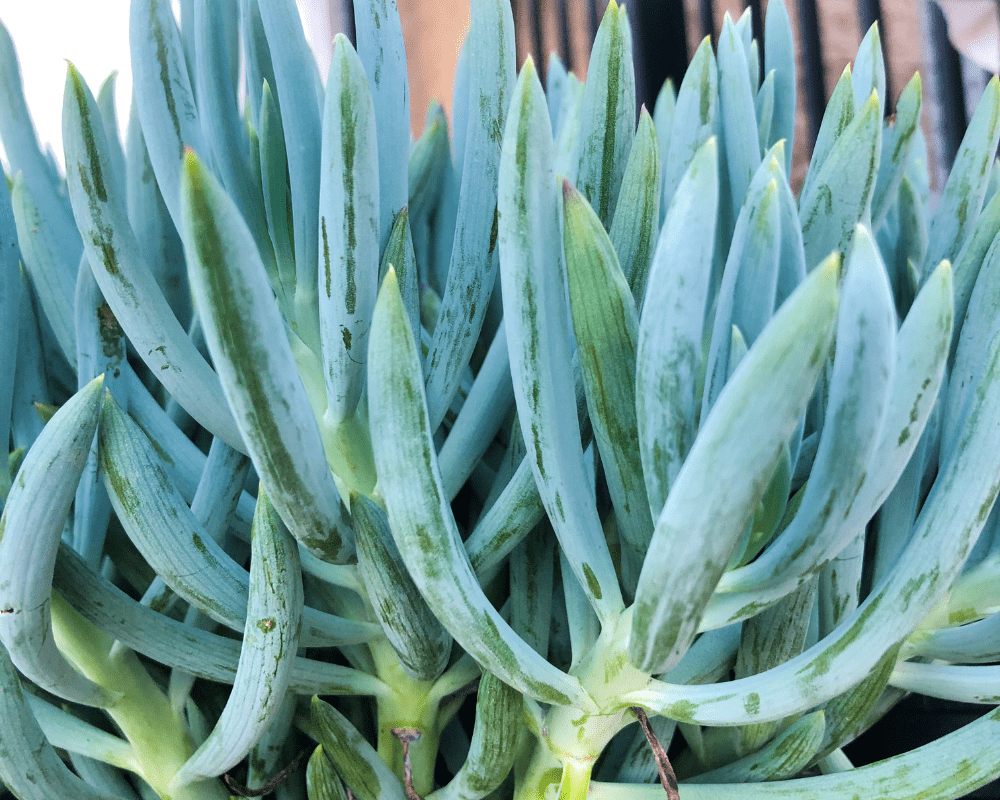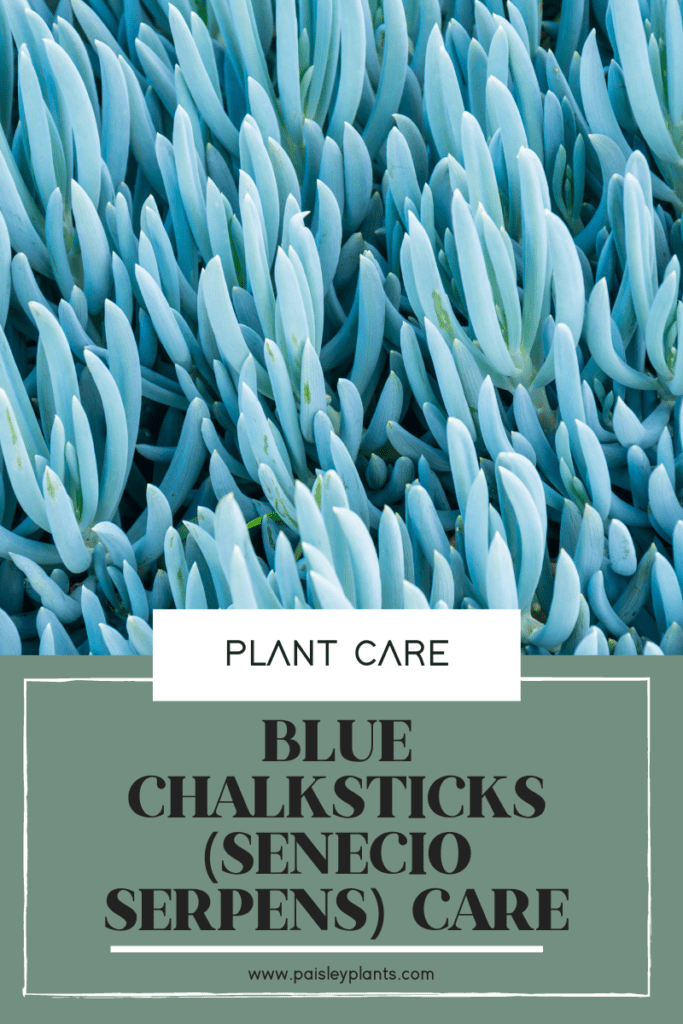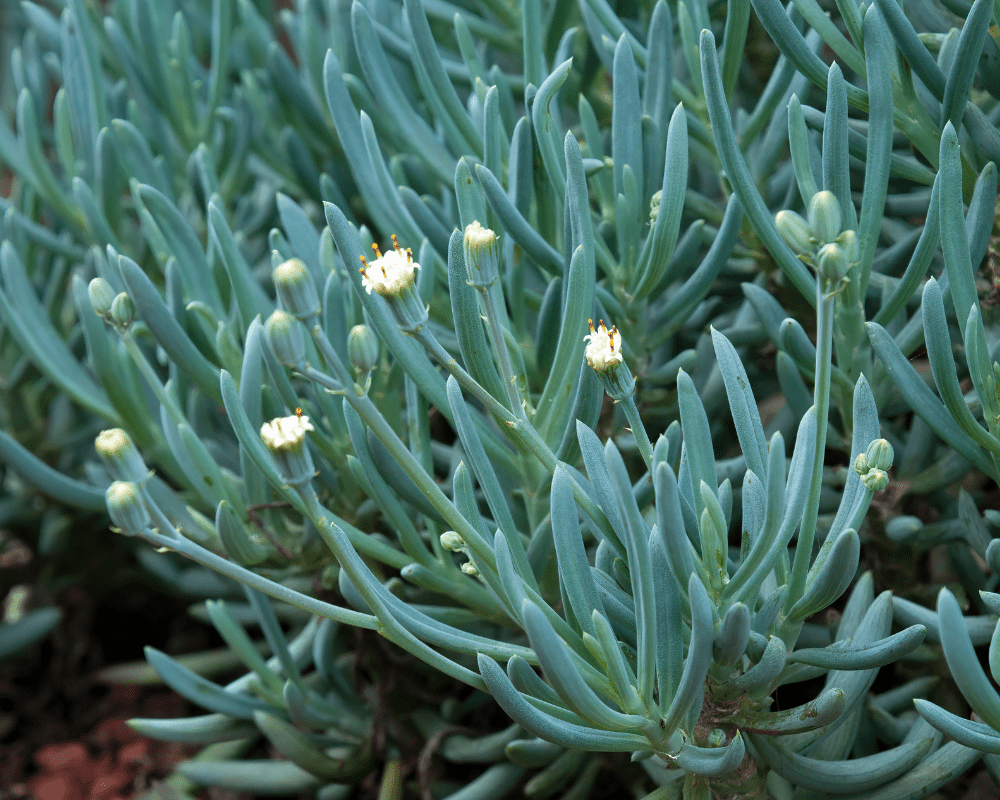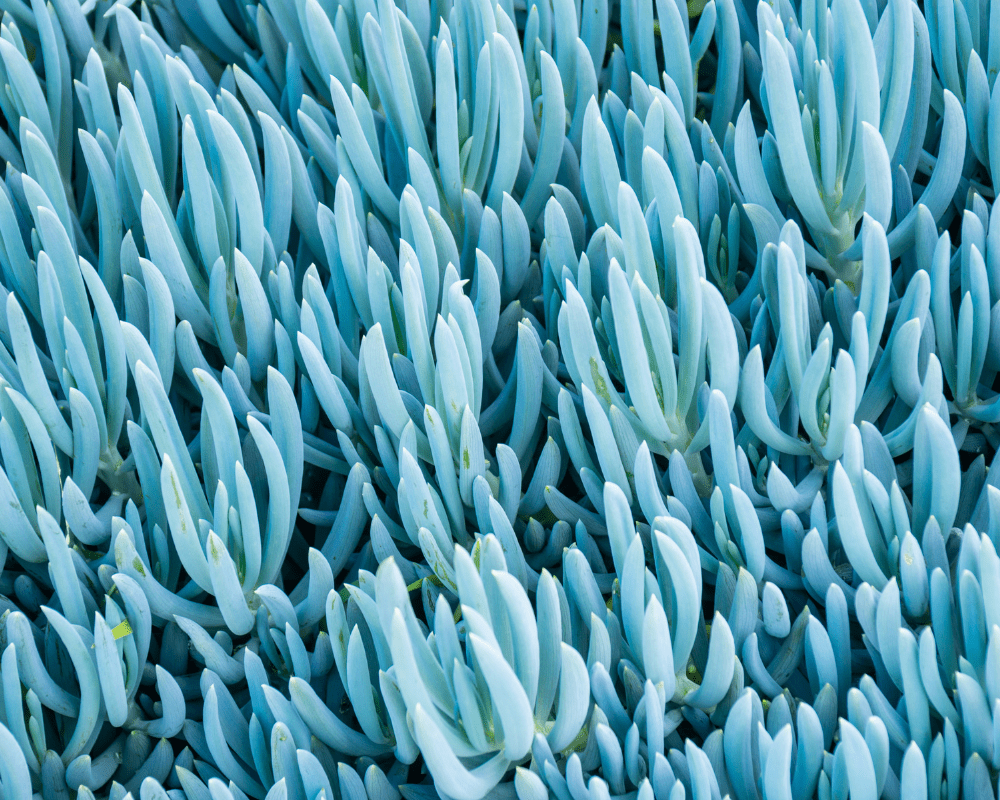What do you think of when you think of a stick of chalk? Do you think of the chalk you played with as a child when you played Hopscotch? Or, if you’re older (like me!) the chalk the teacher used to write on the blackboard in school? And when it would screech down the blackboard sometimes and give you the creeps?
Well, some plants have a name that really describes what they look like. I think that the Blue Chalk Sticks (Senecio Serpens) definitely have that kind of a name. These plants look like a bunch of blue pieces of chalk that are standing upright in a pot or planted in the ground when you see them!
Interestingly, they also are sometimes referred to as Blue Fingers. They do kind of look like a bunch of fingers sticking up out of the soil since they have kind of a fleshy, finger-like leaves. The leaves are about 1.5 inches long and 0.3 inches in diameter.

When grown outdoors, they will grow very densely and form a thick mat. Some people even say they look like shag carpet when they do this! The stems will root at the nodes as they touch the ground and form the dense mat. They make a great ground cover or addition to rock gardens!
The leaves have a pale blue coloring, but if you rub off the chalk on the outside of them, you will notice the blue-green coloring underneath.
Senecio Serpens is very similar to its cousin Senecio Mandraliscae. They are sometimes easily confused since they share such similar names. The difference is that the serpens species grows in a low, delicate groundcover, while the mandraliscae grows higher and more vigorously.
The serpens is considered to be the dwarf version of the mandraliscae species. That’s why it’s considered to be ideal for container gardens and planters and pots. They are very striking in appearance and look great in a garden bed or in pots that you have sitting around your deck or patio.
These plants are native to South Africa. The name “senecio” comes from the Latin word “senex” which means old. Also, when grown in the right conditions, they will flower in the summertime with beautiful small white flowers.
Table of Contents
Toxicity
The Blue Chalk Sticks are not listed on the ASPCA website as a toxic plant for pets. However, this does not mean that you should let them eat this plant! This goes for young children also. If you have young children or pets in your home, use care in where you place your plants and it shouldn’t be any problem.
Caring for your Blue Chalk Sticks

Watering
Overwatering these plants is the biggest problem you will encounter. They are succulents and hold water in their fleshy leaves so don’t need a ton of watering. They can be watered when the soil has dried out and prefer to be on the extra dry side.
You should soak the soil well when watering, then allow it to dry out completely before watering again. Depending on which season it is, you will only need to water every 2 – 3 weeks.
This plant is especially prone to root rot, so you want to be sure you don’t leave it standing in even a little water. Ensure that your pot has sufficient drainage holes and that it isn’t left standing in water for any length of time.
Of course, you’ll want to protect any furniture you keep your plants on with a tray under the pot. I use clear, round plastic trays under all my plants that I purchased very inexpensively on Amazon. These work well and go with any color pot I have. It saves my furniture also from getting moisture all over it and ruining the finish!
Light Conditions for your Blue Chalk Sticks
These succulent plants like full sun so if you have a southern exposure window, place your plant there. If you don’t have a sunny window or spot with plenty of sun, be sure to find a good light source for the plant.
Using a grow light would work well if you don’t have bright light or lots of sun so your plant can have at least 6 – 8 hours of light per day.
The more light it gets, the better it will grow.
It will even tolerate a longer amount of light each day if you choose to use grow lights. Some people recommend using your grow lights for as much as 16 hours per day if you grow your plant indoors. This is up to you, of course.
This will also encourage your plant to flower during the summer months. You could put your plant outdoors providing you have it in a pot that can be moved. Sometimes, having that extra amount of light over the summer months may give it the extra boost it needs to survive the winter months once you bring it back indoors.
It may be hard to believe, but some places don’t get the same light during those long winter months as others do. Did you ever wonder why people go south (from up north) for the winter months? I know this from experience! My plants always seem to do much better during the winter months after I have placed them outside during the summer months.

Soil
It is best to use a gritty, well-drained soil for your Blue Chalk Sticks. They are succulents and require good drainage. You can purchase ready made cactus and succulent soil at a local garden center or online.
Alternatively, you can also make your own growing medium by mixing half perlite and half sand for your potting mix. This will work well as a well-draining soil for your Blue Chalk Stick plant.
Fertilizer
These plants don’t require fertilizing too frequently. They can be fertilized once or twice a year during the growing season with a low-nitrogen succulent plant liquid fertilizer. You can purchase this online or at your local garden center. Follow the package instructions for mixing this and you should be good!
Temperature and Humidity
Blue Chalk Sticks like to be in warmer temps but may tolerate lower temperatures down to 20 degrees F intermittently if you have it on a porch or deck. The average household temperature will be fine for this plant. This would be between 50 – 80 degrees F.
It will also tolerate a normal humidity level in most homes. It can also tolerate a dry home, so you don’t need to place it in a humid environment, which is nice if you live in a dry climate, especially during the cold winter months when your heat is running on a regular basis!

Pests and Diseases
Most succulents such as the Blue Chalk Sticks don’t seem to have much problem with pests, but it is not unheard of. Keep an eye out for any sign of mealybugs or scale insects and if you see either, you should treat these with insecticidal soap.
As far as diseases go, Senecio Serpens are not prone to having problems with diseases. One of the most common problems is root rot due to overwatering, so this should be avoided at all costs. As mentioned above, keep an eye out for any sign of problems or disease and treat them quickly to be sure your plant does not die.
Pruning Blue Chalk Sticks
This small succulent does not require much pruning, but if you choose to do so, the best time to do so is in late summer. However, if your plant becomes too leggy, it is a sign it is searching for a better light source. If this happens, pinching off the extra growth is a good idea. This will encourage bushier growth also.
The cuttings you remove from the plant should be allowed to callous or “harden off” before repotting in soil. This can take a few days. Simply lay them on a paper towel until the ends dry up. Then they will be ready to put into well draining soil to grow new plants!
Repotting Blue Chalk Sticks
If you pinch off leaves from your plant, you can set them aside for repotting. If your plant becomes too large for the pot it is in, you can also repot it in a larger pot. A good rule to follow is that the pot should be large enough for root growth, but not so large that the water will take a longer time to dry up.
This should be done once the plant is rootbound. It is usually recommended that the new pot not be larger than 1 – 2 inches than the older one. Also be sure that it has a drainage hole.
Propagation
Propagating Blue Chalk Sticks should be an easy deal for anyone who wants to do so. Take the pieces of leaves you have hardened off, place them on top of a plate of soil, and spray them with water every day. In about two to three weeks, you should begin to see new growth coming out of the ends of the leaves you placed on top of the soil.
FAQs
The best soil will hold enough water for Blue Chalk Sticks to absorb, but will still dry out quickly so the roots won’t rot. If they sit in wet soil for any period of time, the roots will rot. Ensure this does not happen and your plant should be fine!
These plants are native to South Africa, so they prefer warm temperatures. They would be ideal for a sunroom or any place that stays above 40 degrees. They can be placed outdoors once the temps stay over 40 degrees overnight.
Yes, you can do this. You simply take a cutting from your main plant, place it in water for several weeks until some roots are showing, then pot it in well draining soil. This is an alternative way to propagate your Blue Chalk Stick other than hardening off the roots and planting it directly into soil.
In Conclusion
If you want a striking and different plant to add to your succulent garden, the Blue Chalk Stick might just be the one! It is unique enough that it will be a real eye catcher!
Choose a pot that will coordinate with its blue-green color and it will also add some interest to your plant collection. Or, if you are into contrasting colors, choose a pot that will set off the beautiful color of this plant! Whatever your heart desires!
This plant is considered a great choice for beginning gardeners, so take a chance and try growing one! You will be pleasantly surprised at what a beauty it turns out to be!
Check out other fun succulents here!
